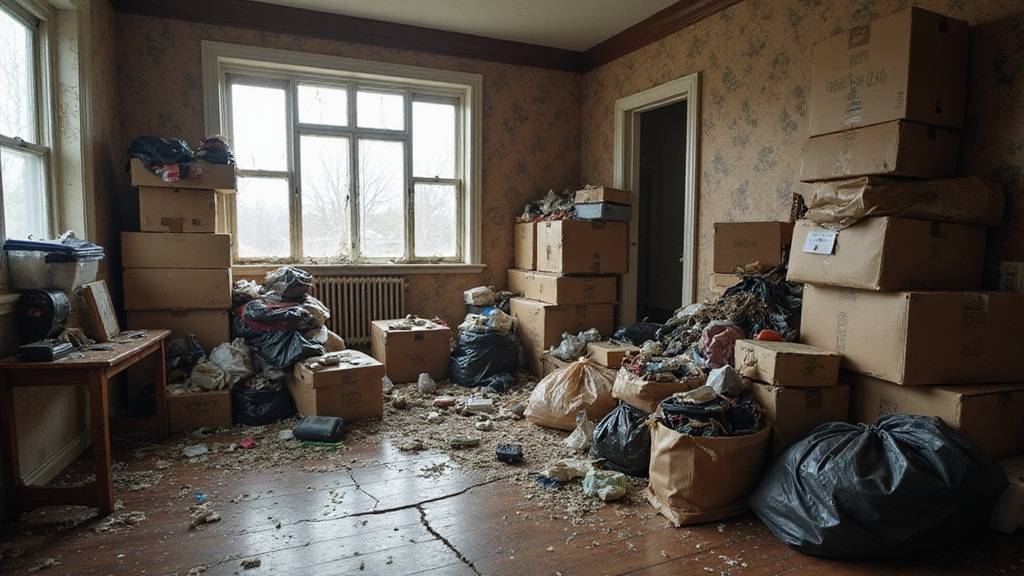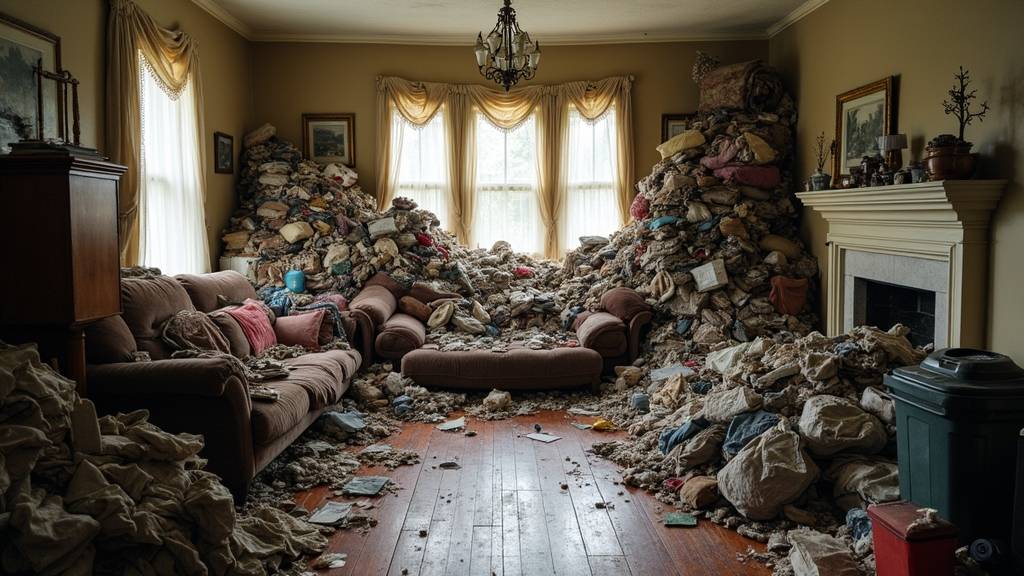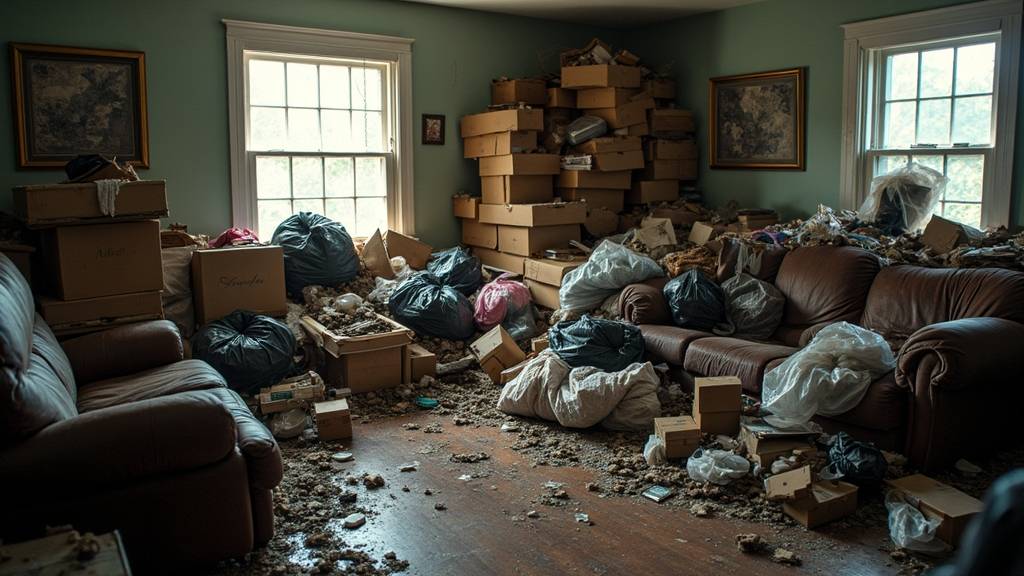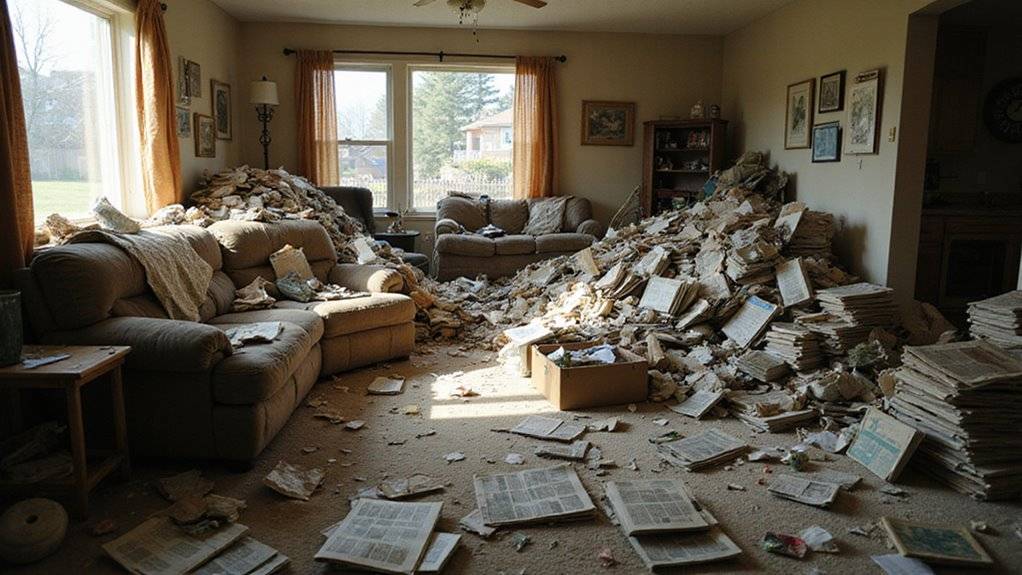Hoarding is more than a private problem; it can seriously affect your home’s value. Cluttered spaces make it hard to spot damage. Buyers often walk away from homes with extreme clutter.
When hoarding takes over, hidden maintenance issues can get worse. Mold, pests, and structural damage may go unnoticed. These problems can lower your property’s worth and make selling much harder.
The good news is you can fix this. Hoarding can lower property value, but tackling clutter restores your home’s appeal and market value.
Taking action now helps protect your investment. This blog will guide you through practical steps to solve hoarding and protect your property’s value.
Key Takeaways
- Hoarding lowers property value by making homes less appealing to buyers and appraisers.
- Excessive clutter can hide structural damage, leading to costly repairs and further reducing value.
- Safety hazards from blocked exits and hidden wiring decrease a home’s desirability and appraisal amount.
- Properties with hoarding issues often require expensive cleanup and restoration, driving down sale price.
- Homes with a hoarding history may attract fewer buyers, resulting in lower offers and longer time on the market.
Understanding Hoarding and Its Causes

Hoarding is not just about keeping too many things. It is a serious psychological issue linked to anxiety and strong emotional ties. If someone cannot throw things away, there may be deeper mental health reasons. Proper testing and removal by certified professionals can be essential if hoarding involves hazardous materials or clutter that poses safety risks. Trauma, stress, or obsessive habits can lead to hoarding behaviors.
People who have faced loss or neglect might find comfort in their belongings. If they lack support, they may depend on possessions even more. Environmental factors also matter in hoarding. If someone grew up in an unstable home, they might collect things to feel in control. Social isolation can make it harder to break the habit. Additionally, understanding mental health factors can help address underlying causes more effectively.
Visible Signs of Hoarding in Residential Properties
When you assess a property, you’ll often notice cluttered living spaces, blocked entryways and exits, and persistent odors from accumulated trash as clear signs of hoarding. These conditions don’t just impact daily living; they signal underlying issues that can dramatically affect a home’s value and safety. Recognizing these visible markers is critical when evaluating the true condition of any residential property.
Cluttered Living Spaces
Cluttered living spaces make it hard to use rooms as intended. Items pile up, blocking walkways and covering surfaces. Daily activities become difficult when clutter takes over main areas.
If a room is packed with items, storage solutions no longer work. Buyers may see clutter as a sign of neglect or extra work. These spaces often lose appeal and lower the home’s value.
Decluttering is difficult when every area is full. Appraisers may give a lower value if they see too much clutter. A neat home looks more attractive and functions better.
Blocked Entryways and Exits
Blocked entryways and exits are clear signs of hoarding in a home. These blockages create safety hazards and can break building rules. If doors or hallways are blocked, people may not be able to escape in emergencies.
Blocked paths can lower your property value and make it harder to sell your home. Interested buyers may worry about bigger problems hidden by the clutter. Insurance companies might also refuse coverage if exits are blocked.
If you clear these areas, you improve safety and increase your home’s value. Removing clutter and using storage solutions will help open up pathways. These actions can also help your home pass safety inspections.
A simple chart can show the effects and solutions:
| Issue | Impact on Property Value | Remedy |
|---|---|---|
| Blocked Doorways | Lowers buyer interest | Declutter regularly |
| Obstructed Exits | Fails safety inspections | Use better storage |
| Impaired Navigation | Negative home appraisal | Clear main pathways |
| Restricted Access | Limits home usability | Remove extra items |
Accumulated Trash and Odors
Accumulated trash and strong odors are clear signs of serious hoarding. These issues show that a property is not being cared for properly. If you notice these problems, it means action is needed.
Trash piles and bad smells can attract pests and cause mold growth. They may also damage the structure of the home over time. These problems can lower the value of the property.
Regular cleaning is not enough if hoarding is severe. Professional cleaning and intervention are usually required in such cases. If addressed quickly, you can protect your investment and make the property safe again.
Impact on Interior Maintenance and Upkeep
When you allow excessive clutter to accumulate, you increase the risk of structural damage as essential repairs and maintenance become nearly impossible. You also make it much easier for hidden pest infestations to take hold, undetected among the piles. Both issues can seriously undermine a property’s integrity and long-term value.
Additionally, selling as-is properties often have a lower market value because of these hidden problems and the perceived need for extensive repairs. Understanding the legal considerations involved in property sales, especially when a property is in poor condition, can help you navigate potential obstacles and protect your investment.
Structural Damage Risks
Too much clutter in your home can cause structural damage. Piles of items may hide leaks, cracks, or mold. Heavy stacks can also stress floors and surfaces.
If you cannot see or reach problem areas, you may miss small issues. Unattended problems can quickly become expensive repairs. Property value may drop if damage grows worse.
Using smart storage and regular cleaning helps keep your home safe. If you ignore these steps, you risk hidden rot or blocked vents. You may also damage your floors or air systems.
Managing your space protects your home and your investment. Regular maintenance is important for structural safety. Clean spaces are easier to care for and inspect.
Hidden Pest Infestations
Hidden pest infestations happen when clutter gives pests like rodents and insects places to hide. Pests are hard to spot early, so they multiply quickly. They can damage wiring, drywall, and insulation, which leads to expensive repairs.
If you organize your space and use good storage, you reduce hiding spots for pests. Regular cleaning and checking for signs of pests is important. If you ignore these steps, infestations can get worse.
Hidden pests can also affect your mental health by causing stress and worry. The longer pests stay hidden, the harder they are to remove. If you want to protect your home and well-being, stay organized and inspect regularly.
Effects on Structural Integrity and Safety

Hoarding can damage a home’s structure and make it unsafe. Piled-up items put extra weight on floors and walls. This can lead to sagging or collapse if the weight is too much. Additionally, the clutter can contribute to home safety issues, increasing the risk of accidents and injuries. Blocked pathways from clutter can stop you from reaching exits in an emergency. If electrical wires are hidden under items, there is a higher risk of fire.
Unsafe wiring can also make it hard to fix problems quickly. Proper storage solutions can help mitigate some of these risks by organizing belongings and reducing hazards. If you ignore these dangers, your home may lose value. Safety risks increase as more clutter builds up. Regular cleaning and organizing can help prevent these problems.
Pest Infestations and Health Hazards
When you allow clutter to accumulate, you create an ideal breeding ground for vermin, mold, and harmful bacteria. These conditions don’t just threaten the building—they directly undermine air quality and introduce serious health risks for anyone inside. Left unaddressed, such hazards can quickly erode both habitability and property value.
Proper disclosure and remediation are essential to protect both your health and your investment. Additionally, We Buy Houses in West County, MO can help address property issues caused by hoarding, ensuring a smooth sale process.
Breeding Ground for Vermin
Hoarded homes are often breeding grounds for vermin. Piles of clutter offer perfect hiding places for pests like rats and insects. If clutter builds up, pests move in and multiply quickly.
Stacks of newspapers and boxes give pests easy access to food and nesting spots. When belongings block access, cleaning and pest control become very hard. Hidden infestations can grow large before anyone notices.
If left unchecked, pests can damage walls, floors, and insulation. Severe infestations may lead to health risks and expensive repairs. A home’s value can drop if pests are present.
Mold and Bacterial Growth
Hoarding often causes dangerous mold and bacterial growth. Clutter blocks airflow and traps moisture. Mold grows well on damp paper, cardboard, and fabrics.
If organic materials are left to rot, bacteria can multiply quickly. Mold and bacteria spread fastest in hidden or uncleaned areas. These problems can damage walls, floors, and ceilings.
If left untreated, bacteria can soak into porous surfaces. Cleaning and fixing these issues can be expensive. An inspector or buyer will notice these problems right away.
If you act early, you can avoid more damage. Quick action protects your home’s value and keeps it safe. Regular cleaning and reducing clutter help prevent mold and bacteria.
Air Quality Deterioration
Hoarding can make the air in your home unhealthy. Clutter blocks airflow and collects dust. This creates a space where pests can live and grow.
Pests such as insects or rodents may appear if clutter increases. These pests leave behind droppings and bacteria. Their presence can cause more allergens in the air.
If dust and mold build up, you may breathe in harmful particles. This can lead to breathing problems or allergies. Poor air quality can also cause stress and worry.
If you use proper storage and keep things clean, you can prevent these problems. A tidy home helps protect your health and property. Good habits make your living space safer for everyone.
Curb Appeal and Neighborhood Perception
Curb appeal directly affects how people see a neighborhood. If a house looks tidy, it helps the whole area seem welcoming. Neighbors and visitors form opinions quickly based on what they see from the street.
Visible hoarding, such as cluttered yards and blocked paths, lowers property appeal. If your house looks messy, nearby homes may lose value too. A neglected appearance can also make others worry about the neighborhood’s overall care. Using good storage and decluttering methods can improve your home’s look.
If you keep your property clean, buyers and appraisers will be impressed. Neat homes support higher property values and stronger community trust. Additionally, home maintenance plays a crucial role in preserving and boosting property worth over time. When a property becomes cluttered or hoarded, it can signal neglect, which often leads to decreased property value and can deter potential buyers.
Influence on Appraisal Values

A home’s outward condition has a direct impact on its appraisal value. If a house appears cluttered or poorly maintained, the appraiser may lower the value. Appraisers look for signs that the property has been well cared for.
Excess clutter can hide damage or block access to important areas. If rooms are hard to enter, the appraiser may assume there are hidden problems. This can result in a lower appraisal. Properly managing property conditions, such as through property maintenance strategies, can help mitigate these issues.
Using storage units or donating extra items before an appraisal can help. Clean and open spaces make it easier for the appraiser to inspect the home. If areas are clear, it shows that the property is properly maintained. Additionally, a clutter-free home can facilitate a smoother selling process, especially if you choose to sell quickly for cash.
Challenges in Selling a Hoarded Property
When you try to sell a hoarded property, you’ll face limited buyer interest because most purchasers prefer move-in ready homes. This reduced demand often means your listing stays on the market much longer than comparable properties. As a result, you may have to accept lower offers or invest in significant clean-up before attracting serious buyers. Additionally, properties in poor condition can deter trustworthy buyers, making it more difficult to close a sale quickly.
Limited Buyer Interest
Hoarded properties attract few buyers because they do not meet most buyers’ expectations. Buyers want clean, move-in-ready homes. Hoarded homes often seem overwhelming and in need of repair.
Most buyers cannot see the home’s potential when there are too many belongings inside. The clutter hides the layout and condition of the rooms. If buyers cannot imagine living there, they lose interest.
Unattractive interiors and poor landscaping create a bad first impression. Buyers may think the house needs expensive cleaning or repairs. If the costs seem too high, they will look elsewhere.
Even in good locations, these problems turn buyers away. Interest usually increases only if the clutter is removed and repairs are made. Addressing these issues can make the property more appealing.
Extended Time on Market
Hoarded homes often stay on the market much longer than clean and organized homes. Clutter and lack of storage make buyers hesitate. If buyers expect a big cleanup, they may lose interest quickly.
Longer time on the market can mean price drops and higher holding costs. Buyers may also think the property is worth less. These factors can hurt your final selling price.
If sellers organize and declutter before listing, homes usually sell faster. Clean, tidy homes attract more buyers and better offers. Good storage solutions can make a big difference.
Legal and Insurance Implications
Hoarding can lead to legal problems and insurance issues. Insurance companies may deny coverage because hoarded homes are higher fire risks. Local laws might be broken if the home is unsafe or unsanitary. If someone gets hurt in a hoarded home, the homeowner could be held responsible. Municipalities may require expensive cleanups or issue fines. Neighbors can also file lawsuits if the hoarding harms them.
If you own or manage a hoarded property, take action early. Address safety risks and talk to your insurance provider. Proactive steps can help you avoid legal trouble and financial loss. Documenting foundation problems and previous repairs can also improve trust with future buyers or insurers. Recognizing the hazards of hoarding can motivate property owners to seek cleanup and remediation efforts before issues escalate.
Stigma and Buyer Reluctance
A home linked to hoarding often loses appeal in the market. Buyers worry about hidden problems, even if the property looks clean. This perception can make selling more difficult.
If a house has a history of hoarding, buyers may expect lingering odors or unseen damage. They might hesitate or offer less money. Some buyers may not consider the home at all.
Sellers usually face fewer interested buyers in such cases. The property’s history can weaken the seller’s position in negotiations. In a busy market, this may lower the home’s final price.
Costs Associated With Cleanup and Restoration
Cleaning and restoring a hoarded property costs more than regular cleaning. Specialized work and equipment are often needed. These extra steps raise the total expense.
Professional cleaners may need to handle biohazards, remove odors, and get rid of pests. If there is damage, repairs or replacements can add even more to your costs. Storage solutions may be required to prevent future hoarding.
If you plan to sell, these costs will lower your property’s value. Buyers may also hesitate if they see high restoration needs. Proper cleanup is important to protect your investment.
Role of Homeowners’ Associations
A homeowners’ association (HOA) helps manage and solve hoarding problems in a neighborhood. The HOA makes and enforces rules for the community. These rules often include how residents must store items and keep yards tidy.
If someone hoards and it becomes visible, the HOA may step in. They might ask the homeowner to clean up or organize the area. Fines or warnings can follow if the problem is not fixed.
HOAs set these rules to protect everyone’s property values. Clear expectations help keep the neighborhood attractive and safe. If everyone follows the rules, the whole community benefits.
Strategies for Addressing Hoarding Situations
Hoarding can lower property values and cause safety risks. Homeowners’ associations must use clear steps to address these situations. It is important to act with both care and practicality.
You should first check how severe the hoarding is. If the problem is minor, simple solutions may work. If it is severe, you may need more help.
Good communication is very important. You must listen to the property owner’s concerns before you suggest changes. If the owner feels heard, they may be more willing to cooperate.
Special storage solutions can help organize the space. You may use shelves, bins, or other tools that fit the person’s needs. If these are used correctly, they can reclaim lost space.
Systematic organizing methods help keep the area neat over time. If you use step-by-step plans, you can make long-term improvements. Each step can reduce clutter and protect property values.
Preventative Measures for Property Owners
Property owners can prevent hoarding with early action. Regular inspections help spot clutter before it becomes a big issue. Early intervention protects property value and prevents damage. Early inspections and quick action safeguard property value and stop clutter from turning into a serious hoarding problem.
Owners should set clear rules for organization and cleanliness. If tenants or family members follow these rules, clutter is less likely to develop. Routine reminders help everyone stay on track.
Smart storage solutions, like shelves or closet organizers, can help keep spaces tidy. These tools use space wisely without letting clutter build up. Owners can recommend these solutions to tenants.
Clear communication about cleaning expectations is important. If problems arise, owners should offer help or refer to cleaning services. This support can stop hoarding before it harms the property.
A culture of cleanliness and order benefits everyone. Properties stay attractive and need fewer repairs. If owners act early, they save money and avoid future problems.
Conclusion
If a property owner ignores hoarding, the value of their home may decrease over time. Hoarding can cause hidden damage and scare away potential buyers. This risk affects both current homeowners and future investments.
If you want to avoid these problems, it is important to address hoarding early. Taking action can help protect your property’s value and create a safer environment. Homeowners who act quickly often see better results when selling.
If you need to sell a hoarded house, we can help. At Freedom Path Investors, we buy houses for cash in any condition. Contact us today to take the next step toward a fresh start.







